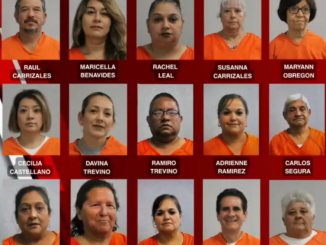
The U.S. Centers for Disease Control and Prevention (CDC) purchased data from tracking companies to monitor compliance with lockdowns, according to contracts with the firms.
The CDC paid one firm $420,000 and another $208,000. That bought access to location data from at least 55 million cellphone users.
The contracts, approved under emergency review due to the COVID-19 pandemic, were aimed at providing the CDC “with the necessary data to continue critical emergency response functions elated to evaluating the impact of visits to key points of interest, stay at home orders, closures, re-openings and other public heath communications related to mask mandate, and other merging research areas on community transmission of SARS-CoV-2,” the contracts, obtained by The Epoch Times, state.
The CDC said it would be using the tracking data to “assess home-by-hour behaviors (i.e. curfew analysis) by exploring the percentage of mobile devices at home during specific period of time.” The data could also be integrated with other information “to provide a comprehensive picture of movement/travel of persons during the COVID-19 pandemic to better understand mandatory stay-at-home orders, business closure, school re-openings, and other non-pharmaceutical interventions in states and cities.”
Under a heading labeled “potential use cases” for the data, the CDC said it could be used to try to connect the forced closures of bars and restaurants with COVID-19 infections and death rates, as well as try to assess the impact of state restrictions on close contact between people outside of their home.
The data could also be used to monitor adherence to mandated or recommended quarantines after arrival from another state and to examine the correlation of mobility patterns and spikes in COVID-19 cases at facilities such as churches, concerts, and grocery stores. It would also enable examining movement restrictions such as curfews to show “patterns” and “compliance,” the contracts state.
The contracts were previously reported on by Vice News, but the outlet only released a screenshot of a single page. Together, the contracts run 71 pages. Both were signed in 2021.
Early Research Published, Unclear What Purchased Data Used For
The CDC, early in the pandemic, received the data for free from the firms, SafeGraph and Cuebiq.
CDC researchers in 2020 published two studies utilizing the data. One focused on data from four U.S. metropolitan areas, finding that people moved around less when measures such as social distancing were imposed. Another found that harsh lockdown orders led to decreased movement, while there was more movement after states began lifting the orders.
Other researchers have also used the mobility data for studies.
No CDC studies were published after the agency bought the data and a CDC spokesperson did not provide examples of what the purchased data were used for.
“For COVID-19, the insights derived from these data provide essential information on the impact and effectiveness of policies and COVID-19 mitigation measures (e.g., jurisdictional stay-at-home orders and business closures) that had profound effects on communities,” Scott Pauley, the spokesperson, told The Epoch Times via email.
“These data provide important insights to protect public health and have been used to understand population-level impacts of COVID-19 policies and can shed important light on other pressing public health problems, like natural disaster response, and toxic environmental exposures. CDC does not and could not use these data for monitoring compliance with COVID-19 orders or individual tracking,” he added.
While the data is deanonymized, it can be used to identify people, researchers have shown.
“The data CDC received were aggregated and anonymous, had extensive privacy protections, and could not be used to identify individuals. They cannot be tied to an individual and have multiple layers of privacy protections to prevent misuse or re-identification,” Pauley said.
Firms like SafeGraph and Cuebiq receive phone data from applications before passing it on to customers in sets. The sets from SafeGraph included “neighborhood patterns,” which showed how often people visited places of interest, where they came from, and where else they went. The sets from Cuebiq included a “shelter-in-place index” that measured the percentage of mobile devices at home during a certain period of time, and an out-of-state traveler set to estimate what percentage of people who came from another state were “failing to shelter in place.”
A SafeGraph spokesperson told The Epoch Times via email that the firm “compiles and provides objective, verifiable facts about physical locations around the world—like the address or operating hours of a particular point of interest,” adding the data it sells cannot be “de-anonymized,” or “used to identify or to ‘track’ the movements or behavior of individual persons.” That’s accomplished in part by introducing “randomized noise,” the company said.
Cuebiq did not respond to a request for comment.
Congressional Concerns
Sen. Ron Johnson (R-Wis.), the top Republican on the Senate Subcommittee on Investigation, expressed concern with the purchase of the mobility data, asking the CDC who approved the purchase and whether it shared the data with other agencies.
“It remains unclear why the CDC tracked millions of Americans during the pandemic and whether it continues to do so. In response to COVID-19, the CDC should have been prioritizing the development of treatments, effective testing, and vaccine safety rather than tracking Americans’ daily lives,” Johnson wrote to CDC Director Dr. Rochelle Walensky.
Walensky said in response that the data was part of “us[ing] the best science available to inform our understanding of the public health impacts of interventions and to inform recommendations.”
The CDC has also utilized location tracking data from Google, but never paid for the data, Walensky said.
She also said that the data that was purchased was not shared with any other agency, or any private companies.
* Article from: The Epoch Times


